Installing a heating pump: how to properly install pumping equipment
The circulation pump increases the efficiency of the autonomous heating system and allows 100% use of all heating circuits.
Professional installation of a heating pump guarantees high performance, reduces operating noise and reduces maintenance and repair costs. Installing the device does not cause any particular difficulties, but there are a number of nuances that are important to consider.
We will tell you how to choose a circulation pump, help you decide on the optimal scheme for inserting equipment into the system, outline installation requirements, and also provide step-by-step instructions for installing the device.
The content of the article:
Purpose of the pump for heating
Previously, circulation pumps were used only in centralized heating systems, and for private housing construction the natural movement of the coolant caused by temperature differences was the norm.
Now forced circulation is used everywhere thanks to the emergence of compact and inexpensive models designed to service the heating networks of small houses and cottages.
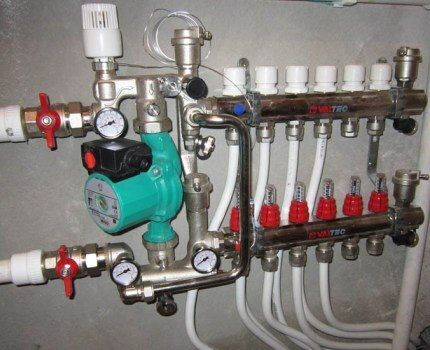
Due to the increase in the speed of movement of the coolant in the pipeline, thermal energy flows faster to the heating radiators, and accordingly, the rooms are warmed up faster. The load on the boiler has decreased because the water is also heated faster.
The need to install bulky and inconvenient large-diameter pipelines has disappeared; contours have become easier to camouflage under floor coverings or be buried in walls.
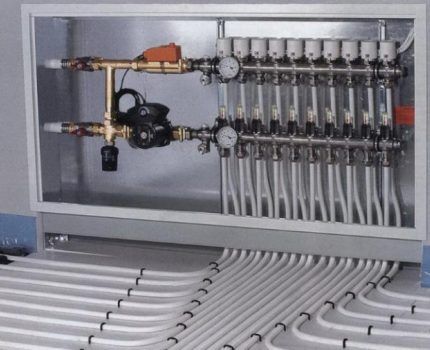
The main disadvantage of pumps for heating systems is their dependence on electricity. If the power supply is intermittent or there is a risk of a complete power outage for some period, it is necessary to install a backup power generator or at least an uninterruptible power supply.
The remaining disadvantages relate to the designs and functionality of various types of devices. For example, monoblock units and devices with a dry rotor are noisier and require constant maintenance, while a pump with a wet rotor is demanding on the quality of the coolant and has a pressure limitation.
Criteria for proper selection of equipment
All installation efforts will be reduced to zero if the equipment is selected incorrectly. In order not to make a mistake, it is necessary to first analyze all aspects of a particular heating system and make the necessary calculations.
Main types of pumps
According to their design features, all devices are divided into 2 categories: with a wet and dry rotor.
Wet pumps. This option is suitable for private homes.The unit is compact, almost silent and has a modular structure that is convenient for maintenance and repair.
But, unfortunately, it does not have high productivity - the maximum efficiency of modern models reaches 52-54%.
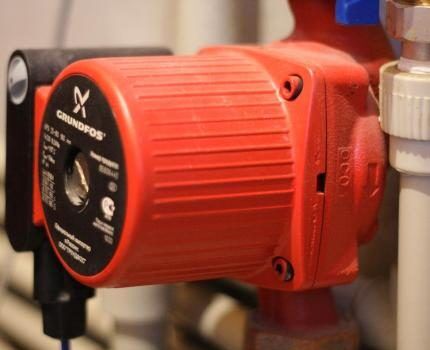
Dry rotor pumps productive, unpretentious to the quality of the coolant, capable of working under high pressure and do not require a strictly horizontal location on the pipe. However, they are noisier, and their operation is accompanied by vibration. Many models are installed on a foundation or metal support frame.
To install console, monoblock or “In-line” models, you must separate room - boiler room. It is advisable to use them when a flow rate of more than 100 m³/h is required, that is, for servicing groups of cottages or apartment buildings.
Brief overview of technical characteristics
When choosing a pump, you should definitely study the technical characteristics and compare them with the requirements of the heating system.
The following indicators are important:
- pressure, which covers hydraulic losses in the circuit;
- performance – volume of water or supply over a certain time interval;
- operating coolant temperature, max and min – for modern models on average +2 ºС… +110 ºС;
- power – taking into account hydraulic losses, mechanical power prevails over useful power.
Structural details are also important, for example, the inlet/outlet diameter of the pipes. For heating systems, the average parameters are 25 mm and 32 mm.
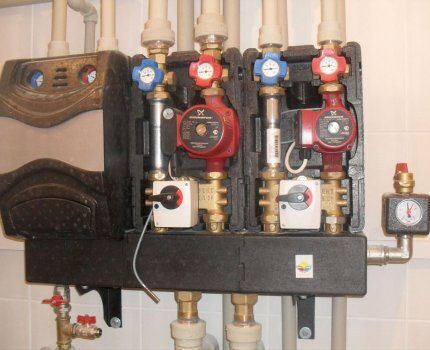
An example of a unit for equipping a residential heating network with an area of 100 m² is a pump Grundfos UPS with a 32 mm pipe connection, a capacity of 62 l/s and a weight of 3.65 kg. The compact and low-noise cast iron device is inaudible even behind a thin partition, and its power is sufficient to transport liquid to the 2nd floor.
Pumps with built-in electronics allow you to quickly switch equipment to a more convenient mode depending on changes in temperature or pressure in the network. Automatic devices are equipped with digital displays that provide maximum information on the operation of the pump: temperature, resistance, pressure, etc.
Additional information on the calculation and selection of a circulation pump for heating is presented in the articles:
- How to calculate a heating pump: examples of calculations and rules for selecting equipment
- Selection of a circulation pump: device, types and rules for choosing a heating pump
- Circulation pump for heating: ten best models and tips for buyers
Requirements for installation of a circulation pump
There are a number of standards that regulate at the legislative level the installation of a circulation pump in a heating system. Some of the rules are set out in SNiP 2.04.05 “Heating...”. For example, it talks about priority forced circulation circuits in heating networks.
Almost all requirements are justified by the operating efficiency of the system as a whole and the circulation device in particular.For example, the shaft of a device with a wet rotor must be installed on the pipe strictly horizontally in level so that there are no air pockets inside and the pump parts do not wear out prematurely.
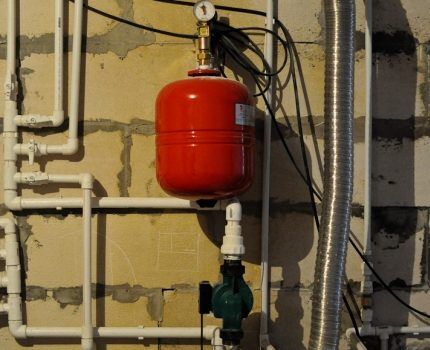
A filter for dirt and abrasive particles is needed in any case, even when installing monolithic models. Filtered coolant will cause much less damage to pump parts than liquid with sand and suspended matter.
The mudguard is installed with the plug down in the direction of water movement to reduce resistance and facilitate system maintenance.
Some rules are dictated by manufacturers. For example, it was customary to install old models of certain brands exclusively on the return line, since they could not withstand high temperatures.
Now pumps have become more versatile and can be installed in any suitable location, but subject to power parameters.
Analysis of installation technology
The installation process itself is quick; to secure the housing, you need to secure two union nuts. This is very convenient for further maintenance and repair work. But before installation, it is necessary to choose the right installation location, otherwise the pump will either work intermittently or will soon fail.
Schemes for inserting a pump into the network
When choosing one of the schemes, it is necessary to take into account the type of heating system, boiler model and ease of maintenance.
Option 1. This is the most common solution: the pump is mounted on the “return”, through which the cooled coolant returns to the boiler.Warm water does not have such an aggressive effect on the parts of the device, so it lasts longer.

Option 2. This solution is relevant if for some reason it is not possible to install a pump on the return line. Then it is fixed at the beginning of the circuit, at the supply, but not near the boiler, but after security groups.
Modern devices can easily withstand high temperatures, but there are still experts who reject such a scheme.
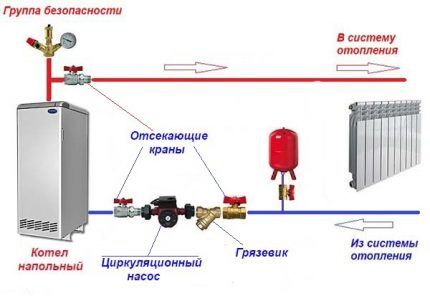
There is such a heating network option as open system with an expansion tank installed at the highest point of the circuit.
If you install a circulation pump, you will be able to operate it in two modes: natural and forced. Natural circulation will come in handy if there are power outages.
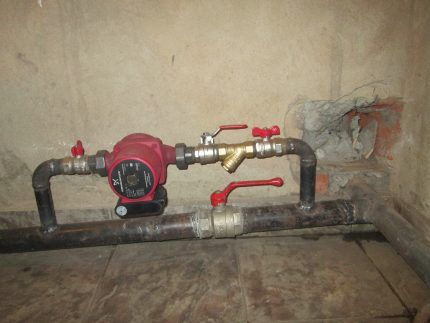
The last scheme applies only to networks with a solid fuel boiler. The supply pump is not installed due to the risk of explosion. The point is that solid fuel boilers It is impossible to quickly stop the heating process, as a result of which the water boils.
Boiling water with steam gets inside the pump, it reduces productivity, the cooled water in the circuit does not have time to flow back into the boiler in the required quantity - and it heats up even more. The result of overheating is an explosion.
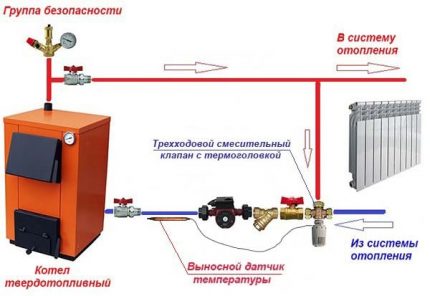
If you run cooled water from the circuit into a heating boiler, condensation will form. To prevent this from happening, the water is first heated in the small circuit to +55°C, and then the thermostatic valve smoothly switches to the large circuit.
As a result, cold water is mixed with already heated water and “temperature shock” does not occur for the boiler.
How piping is done
The circulation pump piping is the equipment necessary for its proper functioning, as well as for the smooth operation of the entire heating system.
First you need to finally decide how many pumps there will be. For one simple circuit, one device is enough, but with complex wiring it is possible to install two or more.
If you plan to use a “warm floor” system in your house or install indirect heating boiler, then it is better to increase the number of devices to two. If two boilers are installed - solid fuel and electric - you will also need a separate pump for each unit.
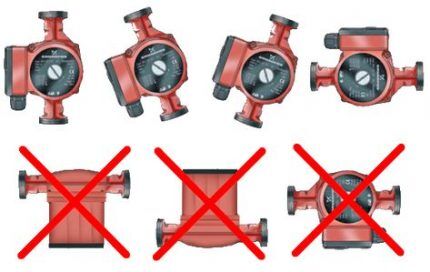
As mentioned above, ball valves are mandatory elements.They are mounted together with the pump, and in the event of an emergency, they will have to be used.
Necessary and check valve made of brass or cast iron so that the coolant moves in one given direction. It is mounted on the pipe immediately after the pump, in the direction of water movement.
A “dirt filter” will be required to prevent solid particles from entering the device housing. Fine filters are not installed in heating circuits. If clean water is needed, it is pre-purified before being poured into the system.
There is a risk of air getting into the network, so there is a need to install an air valve. It can turn on automatically, but there are also manual models.
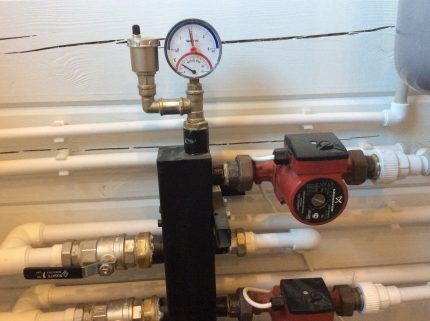
After installing all the devices, the pump is connected to power. A big mistake is to use an ordinary outlet without grounding. This is a safety violation and can cost lives in the event of an accident.
There are smarter ways to power power:
- through uninterruptible power supply (UPS);
- through a differential circuit breaker;
- by connecting to the boiler automation.
The easiest way is to use a circuit breaker: you will need an 8 A switch itself, contacts, and wires. But for practical use, a solution with a thermostat is very convenient.
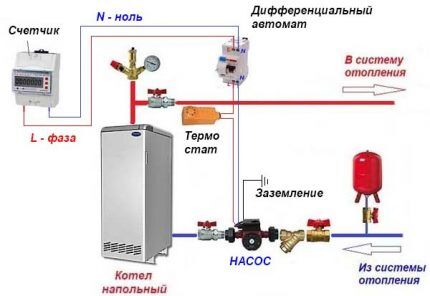
If you plan to install a UPS, you can connect an uninterruptible power supply to both the pump and the boiler at the same time.
Brief installation instructions
A common option is to install the pump on a bypass. This is due to two good reasons: it becomes possible to quickly dismantle or temporarily disconnect the device from the network, for example, if problems arise with electricity.

Various modifications of ready-made pumping units are available for sale: for welding or flange connection, with places for installing taps or valves, with a special area reserved for the pump.
But if you cannot purchase a ready-made unit or there is not enough space for its installation, you can independently organize the bypass piping and fix all the parts in the places allocated for them.
The following tools and materials are required for work:
- a set of open-end or adjustable wrenches for assembly;
- pliers:
- linen thread or tow;
- Unipak sealant.
American nuts are usually supplied with the pump, but taps, adapters or fittings will also have to be prepared. Attention should be paid to more reliable materials for making fittings and the diameter of the products.
Procedure:
- Assembling units with taps. Two will be located on the edges of the pump, the third will become part of a straight pipe. It is important to measure the “return” section in order to accurately weld the fragment with the tap.
- Assembling the pump loop. Tightening the nuts must be postponed until the final stage of installation, but for now they just need to be screwed on.
- Trying on a bypass loop. Mark the places where the units are welded into the pipe.
- Welding, which should be left to a qualified welder.
- Assembling the lower unit - on the “return”
- Connection pump to power supply.
As an example, installing a pump GRUNDFOS.
Maintenance of the installed pump is carried out in operating mode. It is necessary to clean the filter more often and check the pressure gauge readings.
If the values do not correspond to the norm, the device must be removed and adjusted. It is better to do this in a specialized workshop.
Conclusions and useful video on the topic
Theoretical knowledge is quickly absorbed when accompanied by an interesting video that reveals the sequence and features of the work on installing devices.
Video review of the WILO pump – configuration and installation:
Practice shows that advanced home improvement enthusiasts can handle installing a circulation pump on their own.
However, if difficulties arise, it is better to turn to specialists: only qualified craftsmen know how to properly tie and install a heating pump, observing all the nuances of the chosen scheme.
Do you have personal experience installing a circulation pump? Do you want to share your accumulated knowledge or ask questions on the topic? Please leave comments and participate in discussions - the feedback form is located below.




It is better to install two pumps at once. Even expensive devices are very flimsy; sometimes they stop pumping at the slightest touch or vibration of the floor. When installing a pump, it is better to make a separate wiring line with its own switch on the panel. They consume a fair amount of electricity. If the house is warm and there is no small child, then it is better to do without a pump. The costs of the equipment itself, installation and maintenance greatly undermined our family budget. Now we regret that we started this.
Unfortunately, we have found in practice that a pump is not needed in the system - it circulates water and it cools faster. And the gas heats it up again, and the consumption continues. Therefore, at the moment the pump is turned off, and the firebox is moving forward. In view of this, the wood consumption of the KORDI wood-burning boiler has decreased, and very much! I closed the chimney damper one more turn, the pressure gauge reads 70 degrees, the rooms are hot, and we are a winner. Anyone who wants to try it, because the gas industry invented the pump to steal money.
Pumps are needed for heated floors; they are also required where natural circulation is not possible.
If the pressure gauge shows 70 degrees, then everything is clear.
I have 3 underfloor heating loops 30.40 and 60 meters. There is a pump on each loop.I spent a lot of time and a bunch of connection options just so as not to install a pump. Don’t listen to anyone who complains that the floor heating tube will keep warm without a pump.
From my practical point of view, the pump installation video displays a demonstrative demonstration of tightening the union nuts of the pump almost with kid gloves without showing perhaps the main points that lead to leaking connections after such skill during installation, which are troublesome to fix when everything is already installed.
First, the installation of the connection diagram must begin with the pump itself and the water shut-off valves, because the union nuts of the pump have sealing gaskets, which then cannot be tightly compressed with the nuts and, as a result, there will be a leak under one of the gaskets, which you seal next to the first union nut of the pump.
Second, in my opinion, the pump must be mounted on a direct-flow pipe, and not on a bypass pipe or a so-called compensator, since this creates additional resistance, turning laminar coolant flows into turbulent ones, which affects the performance of the pump, etc.
The recommendation I described above is a consequence of the costly repeated independent alteration of the circulation pump wiring diagram before achieving the rational success of properly grown hands.
I ask commentators not to be rude and not to teach spelling, I am already 70 years old, and as you know, the egg does not teach the chicken.